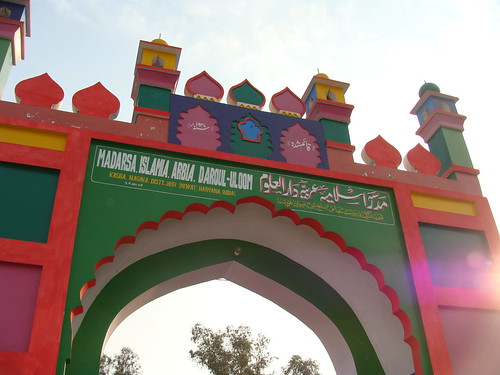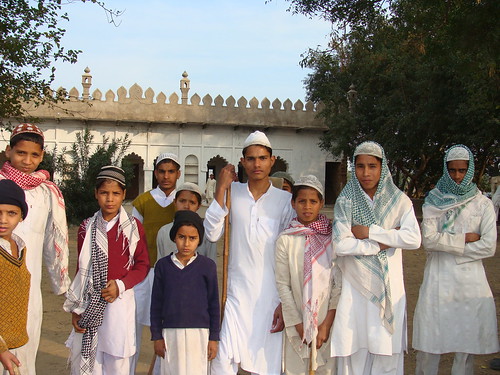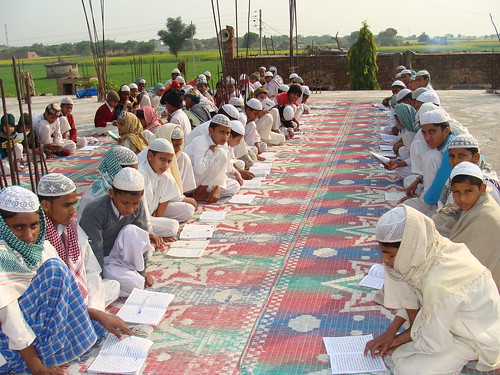Series on Mewat – Part 2
By Yoginder Sikand, TwoCircles.net,
The last time I visited the Madrasa Arabiya Dar ul-Ulum Subhaniya, on the outskirts of Ferozepur Jhirka town—in 1992—it was housed in an ancient, crumbling mausoleum—said to have once hosted the grave of a Shia nobleman who died some 400 years ago. Today, the madrasa has undergone considerable expansion. The sprawling tomb-structure is cemented and neatly whitewashed, a number of low-lying buildings have come up around it, and the madrasa is now surrounded by a well-trimmed lawn with plenty of trees and flowering plants.
Madrasas teaching modern subjects
The founder of the madrasa, the amiable, 60 year-old Maulana Ilyas Qasmi, a graduate of the Dar ul-Uloom at Deoband and currently head of the Haryana wing of the Jamiat ul-Ulema-e Hind, has aged considerably since I last saw him. Yet, he still recognizes me as I step inside, and rushes up to envelop me in a warm embrace. He seats me down on a mattress on the floor and tells me excitedly about the progress his madrasa has made in the years since I last visited it. It now has some 150 students—almost all Meos. In addition to regular Islamic subjects, it now also teaches English, Hindi and Mathematics, till the fifth grade level. Those who teach these subjects are themselves maulvis, though, the Maulana admits, they are not well-qualified for the task. ‘We wish we could appoint better qualified teachers for these subjects, but such teachers demand high salaries, which we cannot afford’, he says.

Maulana Ilyas is a passionate advocate of ‘modern’ education, as well as education for girls. ‘When Islam has forbidden neither of these’, he says, ‘who are some so-called maulvis to forbid them?’ No reliable maulvi has ever issued a fatwa against modern education, he hastens to tell me. All that they are opposed to is blind Westernisation and loss of religious faith, commitment and identity that often characterizes students who study in regular school. Islam and modern education, he says, must go together. The Meos need both, he insists. That is why, he says, madrasas, too, need to reform. ‘Often, madrasa students cannot read English or Hindi, which not only causes many practical problems for them but also causes them to feel inferior, forcing them to depend on others in situations that require knowledge of such languages’, he rues.
Lamenting what he describes as the rapid ‘Westernisation’ of the Meo youth, particularly, he points out, under the influence of television, the Maulana admits that the process appears unstoppable. ‘When people begin to regard something bad as good, it become very difficult to stop it’, he explains. This is another reason, he says, why madrasas must teach their students—would-be ulema—the basics of ‘modern’ subjects. ‘By familiairising themselves with these subjects, they can understand and speak in the language and idiom of the educated classes and explain Islam to them in an appropriate manner’, he points out.
Govt scheme to modernize madrasas
In order to ‘modernise’ Mewat’s madrasas, the Government has instituted a special scheme, Maulana Ilyas tells me. But, he laments, this have made little progress. He cites reports of endemic corruption as one basic cause for its failure. ‘A number of people set up fake madrasas simply to siphon off funds from the scheme’, he says. And, he adds, government servants administering the scheme were said to demand a hefty ‘cut’ before sanctioning money to madrasas that applied to avail of it. To make matters worse, he says, those administering the scheme were not too serious about them—perhaps they were loathe to see the Meo Muslims progress.
Yet another reason why the government-funded scheme for madrasa ‘modernisation’ found few takers in Mewat was because some larger madrasas, in Mewat and elsewhere, vociferously denounced the scheme as an alleged conspiracy against Islam and the madrasas. Maulana Ilyas dismisses this charge as unfair. ‘Some such larger madrasas simply want to maintain their supposed superior position and keep the smaller madrasas below them. Hence their opposition to the scheme. Some of them even went to the extent of announcing a social boycott of the smaller madrasas that wanted to avail of government funds under the scheme’, he relates.

Like a few other madrasas in Mewat, the Madrasa Arabiya Dar ul-Ulum Subhaniya brushed aside the opposition of some maulvis and decided to avail of the Government’s madrasa ‘modernization’ scheme for a period of two years. Under the scheme, the madrasa received a sum of three thousand rupees per month as salary for one teacher appointed for ‘modern’ subjects for every forty students, plus an annual grant of eight thousand rupees to buy equipment. ‘Contrary to what many maulvis had claimed’, Maulana Ilyas stresses, ‘there was no effort on the part of the Government to interfere in the madrasa’s curriculum and system of functioning through the scheme.’
Maulana Muhammad Husain, Maulana Ilyas’ eldest son who helps him run the madrasa, exemplifies a new sort of ulema that is today fast emerging in Mewat—socially-engaged and supportive of ‘modern’, in addition to religious, education for Meo children, both boys and girls. Two of his four sons study at the English-medium Aravalli Public School near Ferozepur Jhirka, and they also attend religious classes in the madrasa after class hours. ‘They are babus during the day and maulvis at night’, Maulana Husain’s friend Qari Sirajuddin jokes. Maulana Husain has high ambitions for his sons. Strikingly, he does not want them to become maulvis like himself and his father. ‘I hope they will become doctors, engineers, lawyers or government officials. But, at the same time, they must have a good grounding in religious education’, he tells me.
Madrasas turning into regular schools
Another institution that I visit on this trip is the Muhammadiya High School, in the village of Sakras, not far from Ferozepur Jhirka. When I saw it last—in 1992—it was a small madrasa. Now transformed into a regular co-educational school, it caters to almost 400 children, a fourth of who are girls. A little more than a tenth of the students of this Meo-run school are Hindus, the rest being Meos. The school follows the syllabus prescribed by the Haryana Board, to which it is affiliated, but it also has facilities for Urdu, Arabic, and Islamic Studies. Although its medium of instruction is Hindi, it arranges for its senior students to take the examinations conducted by the Jamia Urdu, Aligarh.
At the school I met a maulvi—whose name I forgot to ask—who teaches Islamic Studies to students in the primary and middle classes. He opines that it is imperative that the madrasas modernize by introducing at least a basic modicum of modern subjects in their curriculum. This, he says, is crucial especially since in Mewat the ulema continue have a very strong influence, and if they are seen as supporting modern (in addition to religious) education, it can have a very powerful and positive impact on the wider Meo society, inspiring Meo parents to seek modern, in addition to Islamic, education for their children.
At the same time, the maulvi is critical of some maulvis, associated with the larger madrasas, who are vehemently opposed to any sort of modernization, including the government’s madrasa modernization scheme. ‘They are financially strong, so they feel no need to take advantage of this scheme. They fear that through the scheme the government might interfere in their finances’, he surmises. ‘They continue to spread rumours that the government is engaged in a conspiracy to interfere in the madrasas and, thereby, to destroy them in the name of reforms. In this way, they want to keep modern education out of the madrasas’, he continues. He is clear, though, that madrasas must not balk at teaching their students the basics of ‘modern’ subjects—with or without the financial assistance of the government—because, otherwise, he warns ‘madrasas will find themselves anachronistic, being unable to keep up with the times.’ ‘Madrasa students who don’t know a word of Hindi or English feel terribly ashamed when they have to seek the help of others for even such small matters as filing in railway reservation forms or for writing an address on a letter. Being forced to be helpless in such matters is quite contrary to the stature that one expects of the ulema’, he bemoans.
Another man I meet at the school is 68-year old Maulana Kamaluddin Nadwi, a Meo graduate of the renowned Nadwat ul-Ulema madrasa in Lucknow. Uncle of the director of the school, Abdul Ghaffar, he is, in some sense, the main inspiration behind it. ‘Over time’, he tells me, ‘many Meo ulema have changed their position on modern education. Only a few of them—maybe just a fifth—remain somewhat opposed to it in its present form. They fear that the sort of education that is imparted in general schools will impact negatively on the religious identity and commitment of Meo children. At the same time, they realize that the demand for modern education is immense. That is why they have been forced to modify their views.’
Maulana Nadwi comes across as a passionate advocate of what he calls ‘a balanced and holistic Islamic concept of education’, combining both modern as well as Islamic subjects. He does not conceal his differences with those maulvis, such as some very staunch activists of the Tablighi Jamaat, which still remains strong in Mewat, who argue that modern education is opposed to Islam, a claim, he argues, that they assert simply to promote their own vested interests that depend on keeping people ignorant. He recites an Urdu couplet to stress his point:
Mudda tera agar duniya mai hai talim-e deen
Tark-e duniya qaum ko na sikhlana kabhee
(‘If you want to promote religious education in the world, do not teach the community to renounce the world’)

It is not simply out of practical considerations that Maulana Nadwi argues for a healthy mix of both ‘modern’ and Islamic subjects in the madrasas. Rather, he says, his appeal is based on his understanding of Islam, which, he says, countenances no division between religion and the ‘this-worldly’, unlike Christianity. ‘Muslims pray to God for success in both this world and in the life after death’, he reminds me, ‘so how can we, especially our ulema, ignore knowledge of this world?’ ‘The Quran refers to those who have truly submitted to God as the best community, which has been created for the welfare of people’, he poignantly asks, ‘but what welfare can we present-day Muslims provide others when we ourselves have no knowledge of the present world?’
Maulana Nadwi passionately argues the case for Meo girls’ education, lamenting that the Meos have one of the lowest rates of literacy among all the various communities that inhabit India. ‘Islam insists that education is a duty binding on all Muslims, men as well as women’, he says, ‘and hence those who oppose girls’ education, ironically in the name of Islam, adopt a completely anti-Islamic stance.’ In sharp contrast to most other Mewati maulvis, Maulana Nadwi argues that Islam does not prohibit Muslim women from seeking suitable employment outside their homes, if the need so arises, or from playing roles in the public sphere. ‘While abiding by the rules of Islamic decorum, Muslim women must participate in public activities and take up suitable careers. In this way, they can have a salutary impact on people of other faiths who have negative views about Islam, based on serious misunderstandings and on wrong interpretations of the faith on the part of many Muslims themselves’, he stresses.
The winds of change blowing across Mewat have not left even traditional madrasas unaffected. Many of these have now included a basic course in ‘modern’ subjects while continuing to focus mainly on traditional Islamic learning. One such madrasa is the all-girls’ Madrasat ul-Banat Khadjiat ul-Kubra at Patparbas, near the town of Nagina. Established in 1994 by Maulana Syed Muhammad Sulaiman, it is one of Mewat’s only two girls’ residential madrasas. Associated with the Deobandi school, the syllabus it follows is ‘traditional’. Texts penned by numerous Deobandi elders specifically for women, most notably Maulana Ashraf Ali Thanwi’s Bahishti Zevar and Bahishti Sumar, form the core of the madrasa’s five-year maulviyat course, after which students are encouraged to shift to the Jamiat us-Salehat, a large girls’ madrasa in Malegaon, Maharashtra, to train for an additional three years in order to become full-fledged religious scholars or alimas. Presently, some sixty Meo girls, aged between six and fourteen, study and stay at the madrasa. Education is free, but a monthly fee of three hundred rupees is charged for boarding and lodging, but only from those girls whose parents can afford it.
In addition to the core religious or traditional subjects, students at the madrasa now also learn basic English, Hindi and Mathematics, besides practical skills such as tailoring, embroidery, cooking and first-aid. Says Maulana Sulaiman, ‘The Prophet made education a duty for all Muslims, including women. It is as important as food is. The real ulema have never opposed girls’ education or modern education, unlike what is often alleged. Instead, what they are against is immorality, un-necessary intermingling of the sexes, and licentiousness. Otherwise, they have no problem with them.’
That statement I am to hear from almost every Meo maulvi I meet on this trip—a clear indicator of the veritable educational revolution underway quite unnoticed in Mewat today.
(Photos and interviews taken by Mumtaz Alam Falahi of TwoCircles.net)

